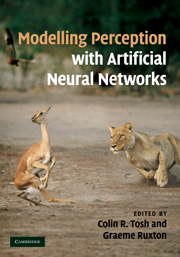Book contents
- Frontmatter
- Contents
- Contributors
- Introduction: Modelling perception with artificial neural networks
- Part I General themes
- Part II The use of artificial neural networks to elucidate the nature of perceptual processes in animals
- Part III Artificial neural networks as models of perceptual processing in ecology and evolutionary biology
- Part IV Methodological issues in the use of simple feedforward networks
- 14 How training and testing histories affect generalisation: a test of simple neural networks
- 15 The need for stochastic replication of ecological neural networks
- 16 Methodological issues in modelling ecological learning with neural networks
- 17 Neural network evolution and artificial life research
- 18 Current velocity shapes the functional connectivity of benthiscapes to stream insect movement
- 19 A model biological neural network: the cephalopod vestibular system
- Index
- References
18 - Current velocity shapes the functional connectivity of benthiscapes to stream insect movement
from Part IV - Methodological issues in the use of simple feedforward networks
Published online by Cambridge University Press: 05 July 2011
- Frontmatter
- Contents
- Contributors
- Introduction: Modelling perception with artificial neural networks
- Part I General themes
- Part II The use of artificial neural networks to elucidate the nature of perceptual processes in animals
- Part III Artificial neural networks as models of perceptual processing in ecology and evolutionary biology
- Part IV Methodological issues in the use of simple feedforward networks
- 14 How training and testing histories affect generalisation: a test of simple neural networks
- 15 The need for stochastic replication of ecological neural networks
- 16 Methodological issues in modelling ecological learning with neural networks
- 17 Neural network evolution and artificial life research
- 18 Current velocity shapes the functional connectivity of benthiscapes to stream insect movement
- 19 A model biological neural network: the cephalopod vestibular system
- Index
- References
Summary
18.1 Introduction
Ecological thresholds have long intrigued scientists, dating from the study of threshold effects for age-specific human mortality (Gompertz, 1825) to present-day investigations for biodiversity conservation and environmental management (Roe & van Eeten, 2001; Folke et al., 2005; Huggett, 2005; Groffman et al., 2006). Defined as a sudden change from one ecological condition to another, ecological thresholds are considered synonymous with discontinuities in any property of a system that occurs in nonlinear response to smooth and continuous change in an independent variable. Understanding ecological thresholds and incorporating them into ecological and socio-ecological systems is seen as a major advance in our ability to forecast and thus properly cope with environmental change (Carpenter, 2002; Rial et al., 2004; Gordon et al., 2008). Consequently, ecologists and economists continue to be extremely attracted to the idea that ecological thresholds may exist and can be used in a management context (Muradian, 2001).
Empirical studies of ecological thresholds are diverse and have grown in number in recent years (Walker & Meyers, 2004). In landscape ecology, a working hypothesis is the existence of critical threshold levels of habitat loss and fragmentation that result in sudden reductions in species' occupancy (Gardner et al., 1987; Andrén, 1994; With & Crist, 1995). As the landscape becomes dissected into smaller and smaller parcels, landscape connectivity – referring to the spatial contagion of habitat – may suddenly become disrupted (With & Crist, 1995).
Information
- Type
- Chapter
- Information
- Modelling Perception with Artificial Neural Networks , pp. 351 - 373Publisher: Cambridge University PressPrint publication year: 2010
References
Accessibility standard: Unknown
Why this information is here
This section outlines the accessibility features of this content - including support for screen readers, full keyboard navigation and high-contrast display options. This may not be relevant for you.Accessibility Information
- 1
- Cited by
